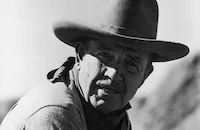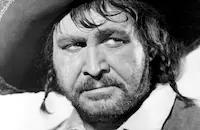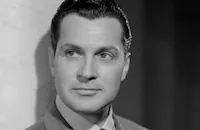Law of the Lawless
Brief Synopsis
Cast & Crew
William F. Claxton
Dale Robertson
Yvonne De Carlo
William Bendix
Bruce Cabot
Barton Maclane
Film Details
Technical Specs

Synopsis
In Kansas in 1889, Pete Stone, son of Big Tom, who runs the state, is jailed for killing George Stapleton. Judge Clem Rogers is called to town to try Pete. His visit attracts the three Johnson brothers, whose fourth brother was sentenced to death by Rogers; a drifter with a score to settle with the judge; and Joe Rile, the murderer of Rogers' father. Rile is in town to work for Big Tom. From his cell Pete arranges for Rogers to have dinner with Ellie Irish, the saloon girl who plans to marry Pete for the sake of security. Pete plans to have his lawyer select a jury of prudes who might be influenced against the judge because of his association with a saloon girl. The Johnson brothers and the drifter try to waylay Rogers, but a deputy sheriff discovers them and kills them in a gun battle in which he himself is killed. Big Tom orders Rile to draw Rogers into a gunfight after the trial, but in a manner that will discredit the judge regardless of the outcome. The attempts to trap Rogers with Ellie fail. At the trial it is learned that Stapleton told Pete to keep away from his wife and that Pete forced him to draw and then gunned him down. Stapleton's widow testifies that she has never seen Pete before, but Ellie testifies that she saw Pete embracing the woman and was warned to keep silent. Pete is found guilty and sentenced to be hanged. Then Rile accosts Rogers, but the judge refuses to be drawn into a fight; and Rile, too, throws down his gun. Big Tom then tries to kill Rogers, but Rile disarms him. As the vindicated judge leaves town, Big Tom's orders to kill him are ignored by Big Tom's own men.

Director
William F. Claxton
Cast

Dale Robertson

Yvonne De Carlo

William Bendix

Bruce Cabot

Barton Maclane

John Agar

Richard Arlen
Jody Mccrea

Kent Taylor

Bill Williams
Rod Lauren
George Chandler

Lon Chaney Jr.

Donald Barry
Roy Jenson
Jerry Summers
Reg Parton
Alex Sharp
Romo Vincent
Lorraine Bendix
Joe Forte
Leigh Chapman
Dick Ryan
Crew
Jerry Buss
Sam Comer
Steve Fisher
Harry F. Hogan
Paul K. Lerpae
Otho Lovering
A. C. Lyles
A. C. Lyles
Nellie Manley
Frank Mcwhorter
Hal Pereira
Al Roelofs
Pat B. Rooney
Lester Shorr
Darrell Silvera
Wally Westmore
John Wilkinson

Film Details
Technical Specs

Articles
TCM Remembers - John Agar
Popular b-movie actor John Agar died April 7th at the age of 81. Agar is probably best known as the actor that married Shirley Temple in 1945 but he also appeared alongside John Wayne in several films. Agar soon became a fixture in such films as Tarantula (1955) and The Mole People (1956) and was a cult favorite ever since, something he took in good spirits and seemed to enjoy. In 1972, for instance, the fan magazine Famous Monsters of Filmland mistakenly ran his obituary, a piece that Agar would later happily autograph.
Agar was born January 31, 1921 in Chicago. He had been a sergeant in the Army Air Corps working as a physical trainer when he was hired in 1945 to escort 16-year-old Shirley Temple to a Hollywood party. Agar apparently knew Temple earlier since his sister was a classmate of Temple's. Despite the objections of Temple's mother the two became a couple and were married shortly after. Temple's producer David Selznick asked Agar if he wanted to act but he reportedly replied that one actor in the family was enough. Nevertheless, Selznick paid for acting lessons and signed Agar to a contract.
Agar's first film was the John Ford-directed Fort Apache (1948) also starring Temple. Agar and Temple also both appeared in Adventure in Baltimore (1949) and had a daughter in 1948 but were divorced the following year. Agar married again in 1951 which lasted until his wife's death in 2000. Agar worked in a string of Westerns and war films such as Sands of Iwo Jima (1949), Breakthrough (1950) and She Wore a Yellow Ribbon (1949). Later when pressed for money he began making the films that would establish his reputation beyond the gossip columns: Revenge of the Creature (1955), The Brain from Planet Arous (1957), Invisible Invaders (1959) and the mind-boggling Zontar, the Thing from Venus (1966). The roles became progressively smaller so Agar sold insurance and real estate on the side. When he appeared in the 1988 film Miracle Mile his dialogue supposedly included obscenities which Agar had always refused to use. He showed the director a way to do the scene without that language and that's how it was filmed.
By Lang Thompson
DUDLEY MOORE, 1935-2002
Award-winning actor, comedian and musician Dudley Moore died on March 27th at the age of 66. Moore first gained notice in his native England for ground-breaking stage and TV comedy before later building a Hollywood career. Like many of his peers, he had an amiable, open appeal that was balanced against a sharply satiric edge. Moore could play the confused innocent as well as the crafty schemer and tended to command attention wherever he appeared. Among his four marriages were two actresses: Tuesday Weld and Suzy Kendall.
Moore was born April 19, 1935 in London. As a child, he had a club foot later corrected by years of surgery that often left him recuperating in the hospital alongside critically wounded soldiers. Moore attended Oxford where he earned a degree in musical composition and met future collaborators Peter Cook, Jonathan Miller and Alan Bennett. The four formed the landmark comedy ensemble Beyond the Fringe. Though often merely labelled as a precursor to Monty Python's Flying Circus, Beyond the Fringe was instrumental in the marriage of the piercing, highly educated sense of humor cultivated by Oxbridge graduates to the modern mass media. In this case it was the revue stage and television where Beyond the Fringe first assaulted the astonished minds of Britons. Moore supplied the music and such songs as "The Sadder and Wiser Beaver," "Man Bites God" and "One Leg Too Few." (You can pick up a CD set with much of the stage show. Unfortunately for future historians the BBC commonly erased tapes at this period - why? - so many of the TV episodes are apparently gone forever.)
Moore's first feature film was the 1966 farce The Wrong Box (a Robert Louis Stevenson adaptation) but it was his collaboration with Peter Cook on Bedazzled (1967) that's endured. Unlike its tepid 2000 remake, the original Bedazzled is a wolverine-tough satire of mid-60s culture that hasn't aged a bit: viewers are still as likely to be appalled and entertained at the same time. Moore not only co-wrote the story with Cook but composed the score. Moore appeared in a few more films until starring in 10 (1979). Written and directed by Blake Edwards, this amiable comedy featured Moore (a last-minute replacement for George Segal) caught in a middle-aged crisis and proved popular with both audiences and critics. Moore's career took another turn when his role as a wealthy alcoholic who falls for the proverbial shop girl in Arthur (1981) snagged him an Oscar nomination as Best Actor and a Golden Globe win.
However Moore was never able to build on these successes. He starred in a passable remake of Preston Sturges' Unfaithfully Yours (1984), did another Blake Edwards romantic comedy of moderate interest called Micki + Maude (1984, also a Golden Globe winner for Moore), a misfired sequel to Arthur in 1988 and a few other little-seen films. The highlight of this period must certainly be the 1991 series Orchestra where Moore spars with the wonderfully crusty conductor Georg Solti and leads an orchestra of students in what's certainly some of the most delightful television ever made.
By Lang Thompson

TCM Remembers - John Agar
Quotes
Trivia
Notes
Working titles: Invitation to a Hanging and The Day of the Hanging.














